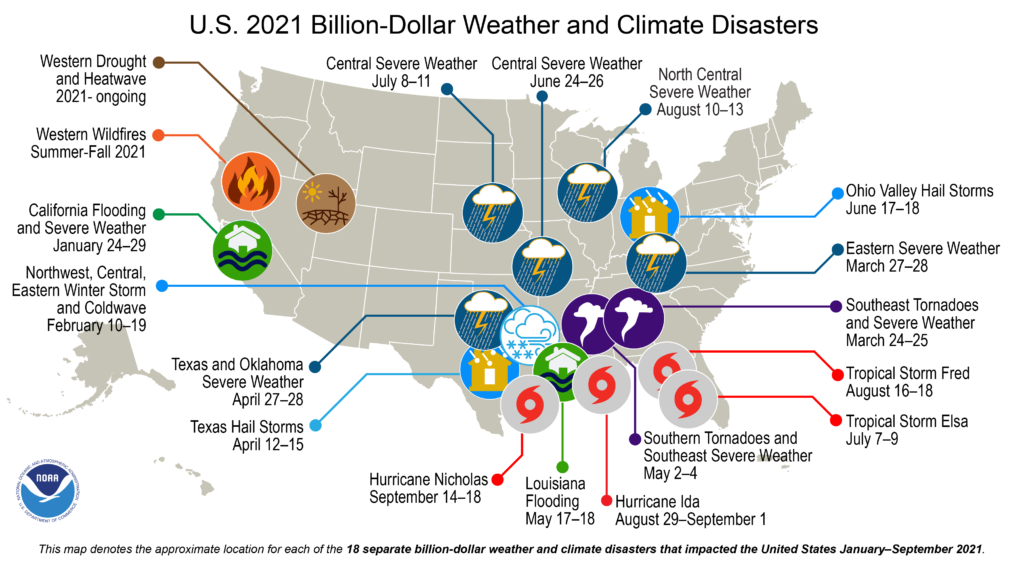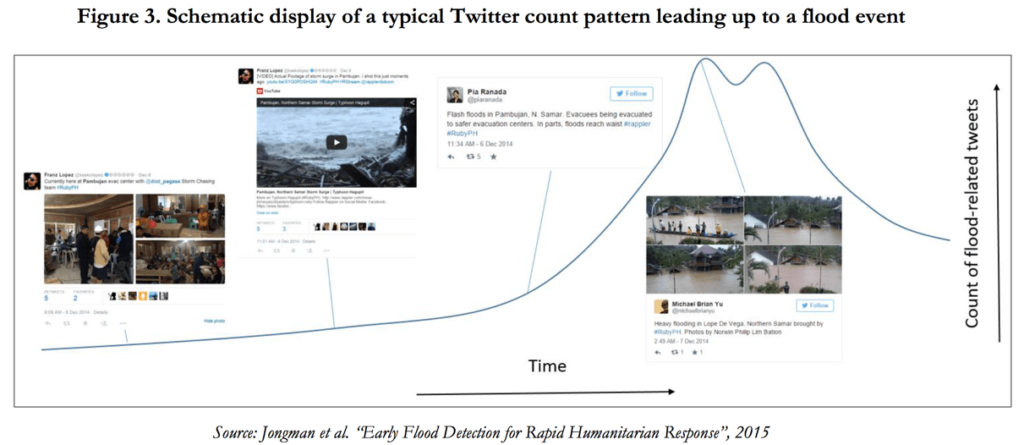With the rise of natural disasters exacerbated by climate change, governments and agencies struggle to coordinate effective relief programs. Artificial intelligence (AI), machine learning (ML), and natural language processing (NLP) can help. Here’s how.
The cost of natural disasters is at an all-time high
Natural disasters wreak havoc around the world every year. But it’s hard to appreciate the scale of this damage.

As of October 2021, there have been 18 climate and weather-related disaster events in the U.S. alone, each causing more than $1 billion each, according to the NOAA National Centers for Environmental Information (NCEI), formerly known as the National Climatic Data Center (NCDC).
Hurricane Ida’s price tag topped $64.5 billion, according to NOAA. Meanwhile, a historic cold wave that blew through the northwest, central and eastern United States, famously leaving millions in Texas without power for days, caused more than $20 billion in damages. Historic wildfires and drought conditions continued throughout California and the Pacific Northwest in 2021, and torrential floods and mudslides afflicted Washington and British Columbia, Canada, decimating roads, bridges, and railways, leading to thousands of evacuations and at least four deaths.
And, of course, these numbers only tell part of the story. The humanitarian impact is incalculable.
Relief agencies are struggling
Governments around the world are struggling to coordinate effective, efficient programs. The U.S. Senate, for example, recently passed a bill that would allow the reallocation of surplus Covid funding to address continuing impacts from recent climate-related disasters.
There’s lots of data out there around disaster relief, but making use of it is easier said than done. Disaster data is often fragmented, incomplete, or difficult to access.
The scope is challenging, too. There’s just so much data out there.
Relief agencies and governments need to turn this information into useful insights. But while many techniques for processing crisis data already exist, this technology usually captures a limited amount or type of data. It only goes so far in coordinating disaster relief efforts.
The role of AI and machine learning in disaster relief
Recent advances in machine learning and artificial intelligence are allowing researchers, engineers, and scientists to access and analyze new and more extensive data sources than ever before.
By combining AI and ML with data analytics technologies like natural language processing, experts are creating a new breed of AI. These systems enable users to ask specific, targeted questions and receive useful answers drawn from messy, real-world datasets.
Governments and relief agencies are beginning to use these tools to coordinate better disaster relief programs. For example, large-scale behavior and movement data, run through predictive machine learning models, can help officials distribute supplies to where people are going rather than where they were.
Predictive analytics programs like these are still in their early stages but offer a promising new approach to disaster relief.
In short, the role of AI in disaster relief is to help governments and relief agencies parse through large volumes of complex, fragmented data to generate useful information that they can act on more quickly than before.
Using social data analytics and AI to respond faster to floods and other natural disasters
Researchers at the Vrije University Institute for Environmental Studies in Amsterdam published a research paper exploring how analyzing Twitter activity can help to detect flood events.
The researchers found that by combining data from disaster response organizations, the Global Flood Detection System (GFDS) satellite flood signal, and flood-related Twitter activity, disaster relief organizations can “gain a quicker understanding of the location, the timing, as well as the causes and impacts of floods.”
Of course, the sheer volume of Twitter data (350,000 tweets per minute) creates huge problems for anyone trying to make use of it. To solve this issue, some projects are turning to AI and machine learning.
One of the more recent examples of the use of machine learning and NLP in disaster — in this case, pandemic — response, was early during the coronavirus pandemic when researchers analyzed social media, web, and news outlets to monitor the spread of the disease. By looking for posts that mentioned Covid-specific symptoms, scientists could see where new hotspots were arising and could tell early on that younger patients were more resilient to the disease. Indeed, some of the most valuable data generated during a crisis come from social media users and on-the-ground aid workers. Images and comments from Twitter, Facebook, Instagram, and Youtube, for example, can help experts make initial damage assessments. This information can also help rescue workers find disaster victims more quickly while identifying and mapping new disaster sites in need of aid.
Finally, combining satellite imagery data, seismometers, and location-tagged social media comments can help relief organizations provide early warnings and verify reports in real-time.
Further reading
- Natural disasters are increasing in frequency and ferocity. Here’s how AI can come to the rescue — World Economic Forum
- Ready for the Next Storm: AI-Enabled Situational Awareness in Disaster Response — Johns Hopkins Applied Physics Laboratory
- How AI Can Be Used as a Disaster Preparedness and Support System — Forbes Tech Council
